Day 01 : Arrival Delhi. 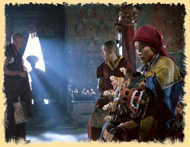
Late night arrive Delhi. Meet assist and transfer to Hotel. Overnight.
Day 02 : Delhi- Leh.
In time transfer to airport to board flight for Leh. Upon arrival meet, assist and transfer you to Hotel in Leh. Rest of the day free to acclimatize to the high altitude of Ladakh. In the evening take a walk to the local bazaar in Leh. Overnight at Hotel in Leh.
Day 03 : Leh Sight seeing.
Morning after breakfast half day sight seeing of Sankar Gompa, Shanti Stupa and Leh Palace. Evening free to walk around the bazaar. Overnight at hotel in Leh.
SANKAR GOMPA & VILLAGE : A relatively modern monastery, it is closely associated with the Spituk monastery and served as the residence of the late head priest-Kushak Bakula. A number of gold icons are to be found here.
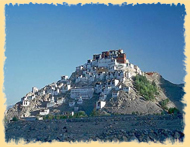 SHANTI STUPA (Japanese Peace Pagoda) : Shanti Stupa/Japanese peace pagoda is build by a Japanese religious organization headed by Head monk Nakamura with the help from the organization and local people. It is situated at a hill top in Cahngspa village providing a bird eye view of the Leh town and the surrounding mountain peaks. Architecturally it has the Japanese touch with small clean rooms on the side for meditators and the main Japanese shrine at the entrance. SHANTI STUPA (Japanese Peace Pagoda) : Shanti Stupa/Japanese peace pagoda is build by a Japanese religious organization headed by Head monk Nakamura with the help from the organization and local people. It is situated at a hill top in Cahngspa village providing a bird eye view of the Leh town and the surrounding mountain peaks. Architecturally it has the Japanese touch with small clean rooms on the side for meditators and the main Japanese shrine at the entrance.
LEH PALACE : The Namgyal Tsemo (victory Peak) was build by King Tashi Namgyal after the reunification of upper and lower Ladakh and victory over Hor and their bodies are placed under an image of Mahakala, the guardian deities to stop further invasion of Hor. The Leh palace known as 'Lechen Palkhar' was built by Singay Namgyal around in the beginning of 17th Century A.D. The nine-storied palace is now deserted, and the ASI (Archeological Survey Of India) has taken up the renovation work.
Day 04 : Indus Valley Monastery tour (120 Kms round trip)
Morning after breakfast, drive to Thiksey village, visit Thiksey monastery and drive to Shey Village to visit Shey Palace and Gompa. Continue drive to Hemis monastery to visit one of the most famous monasteries of Ladakh. Later on the way back to Leh Visit Stok Palace and Museum. Come back to Leh in the evening and relax at the hotel. Dinner and overnight at the hotel in Leh. 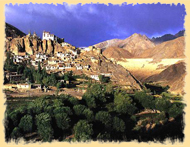
THIKSEY GOMPA: 19 Kms from Leh, spectacularly sited, Thiksey is one of the largest and architecturally most impressive Gompas. There are several temples in this Gompas, containing images, stupas and wall paintings of Buddha, which are exquisite.
SHEY PALACE AND GOMPA: Situated on a hillock 15 Kms upstream from Leh, it was once the residence of the royal family. According to tradition, it was the seat of power of the pre-Tibetan kinds. A 7.5 mts high copper statue of Buddha, plated with gold and the largest of its kind, is installed here.
HEMIS GOMPA: 40 Kms from Leh, it is the wealthiest, best known and biggest Gompa of Ladakh. Its popularity stems from the major annual festival held here in summer. The festival is in honor of Guru Padma Sambhava’s birth anniversary. It also has the largest Thanka in Ladakh which is unfurled once in 12 years Hemis was built in 1630 during the reign of Singge Namgyal, an illustrious ruler of Ladakh. It flourished under the Namgyal Dynasty for the royalty favored the Drugpa sect, which is managed the monastery. It is divided into two, the assembly hall on the right and the main temple on the left. The hall (Dukhang) is also used as “green room” by the dancers during the festival. The temple is known as Tshogkhang. The verandahs have a surfeit of frescoes, among them the Buddhist “Wheel Of Life” (Kalachakra) and the lords of the four quarters, besides the prayer wheel.
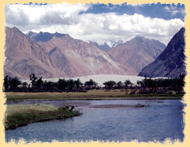 STOK PALACE & MUSEUM: The palace of the banished royal family, Stok has a museum which displays fabulous period costumes and jewelry of the royalty along with exquisite Thankas representing the life style of Shakya Muni. Interesting historical objects like coins, armor, weapons, precious jades and porcelain too can be seen here. STOK PALACE & MUSEUM: The palace of the banished royal family, Stok has a museum which displays fabulous period costumes and jewelry of the royalty along with exquisite Thankas representing the life style of Shakya Muni. Interesting historical objects like coins, armor, weapons, precious jades and porcelain too can be seen here.
Day 05 : Leh – Alchi (75 Kms)
Morning after breakfast drive to Alchi with packed lunch. Enroute visit, Magnetic Hill, Confluence of Zanskar and Indus river, Basgo Fort and Likir Monastery. Arrive Alchi and visit Alchi Monastery. Dinner and overnight at hotel / camp in Alchi.
MAGNETIC HILL : Defying the Law of gravity. This place is close to the Gurdwara Shri Patthar Sahib. It has been noticed that when a vehicle is parked on neutral gear on this metallic road the vehicle slides up-hill that’s the Believe it or not of Ladakh!
CONFLENCE OF THE ZANSKAR & INDUS : On way to Sham Valley before Nimu village one can have this magnificent view of two rivers in wed-lock! In seasons they have different colors and flow and wildness.
BASGO GOMPA : 40 Kms downstream from Leh, it was the seat of power of branch of a Namgyal family. It was here in 1680 that invading Mongol and Tibetan armies were held in check over a three year old siege. Original 16th century murals and other arts at Basgo are well worth a visit. 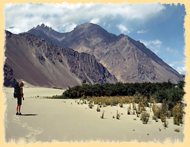
LIKIR GOMPA : Founded in the 11th century and rededicated to a different monastic order in the 15th century, its earlier Gompa was destroyed in a fire. The present Gompa dated back to the 18th century. Skilled craftsmen producing excellent Thankas, earthen pots and carved wooden folding stools, live here in the village. Majestically situated, Likir commands a spectacular view. A magnificent giant Jupiter tree, one of the few survivors of its species, stands in the courtyard.
ALCHI GOMPA : 70 Kms from Leh, on the banks of the Indus, is the Alchi Gompa dating a thousand years back. One of its walls features thousands of miniature sized pictures of the Buddha. Three large sized images made of clay and painted brightly are its focal attractions. No longer an active religious center, it is looked after by monks from the Liker monastery. This is the only monastery amongst 34 monasteries, which is not located on a hilltop.
Day 06 : Alchi - Lamayuru - Leh. (180 Kms round trip)
Early morning drive to Lamayuru. Lamayuru is famous for its ancient monastery and the surrounding landscape which closely resembles the surface of moon. This is where Ladakh gets its name ‘The Moonland’. Later visit the Rizong monastery and Chulichan nunnery and drive back to Leh. Dinner and overnight at hotel in Leh.
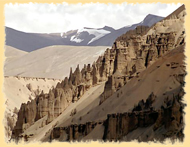 LAMAYURU GOMPA: The oldest holy site in Ladakh, it was a bon shrine prior to the advent of Buddhism. Also known as Yung Drung (Swastika) it is sited on a high promontory overlooking the village and valley. For sheer spectacle value no other Gompa can match Lamayuru. LAMAYURU GOMPA: The oldest holy site in Ladakh, it was a bon shrine prior to the advent of Buddhism. Also known as Yung Drung (Swastika) it is sited on a high promontory overlooking the village and valley. For sheer spectacle value no other Gompa can match Lamayuru.
RIDZONG GOMPA: Rizong is the most isolated monastery of all the monastery of Ladakh. Rizong Gompa is known as the paradise for Meditation. Guru Padma Sambhava is believed to meditate here for years. One can still find the small caves where Lamas used to meditate for years cutting themselves from the rest of the world except for an one feet square outlet window from where they accept the one time meal of the day.
CHULICHAN: Chulichan, the nunnery is around one and half Kms. below the Rizong monastery; around 20 Nuns resides at Chulichan. They provide food and cloths to the monks and perform morning and evening prayers.
Day 07 : Leh - Nubra Via Khardungla Pass.
Early morning proceed to Nubra Valley via the World Highest Motorable road (5602 Mts) Khardungla pass. Arrive Nubra by noon and check in at Hotel / Camp. Evening at leisure. Overnight at the hotel / camp.
KHARDUNGLA PASS: The road journey to Nubra valley leads through Khardung La pass (The highest Motorable road in the world) 18,390 ft. around 39 Kms. Away from Leh. There are two checkpoints on the both sides of the pass. Khardong is the first village of Nubra valley at higher altitude than Deskit and other villages.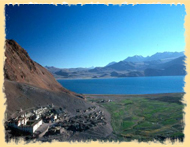
Day 08 : Nubra Sight seeing.
Morning after breakfast proceed for a visit to the White Sand Dunes at Hunder. You can enjoy the camel ride (On Own). Visit Hunder and Diskit monasteries. Evening trek to Samstaling Monestry. Overnight at the hotel / camp.
DESKIT VILLAGE: Deskit is the main village of headquarter of Nubra valley, which has a small market consisting of a row of shops and about 500 years old Gompa on the hilltop. Spectacular view of the valley can be seen form the monastery.
DESKIT GOMPA: Deskit Gompa was founded by Lama Sherab Zangpo of Stod in about 1420 AD during the reign of King Dragspa. About 100 monks are residing in the Gompa, which is a branch of Thikse Monastery. The monastic festival called Gustor takes place on 20th and 21st days of the 12th month of Tibetan calendar.
HUNDAR VILLAGE: Hundar is a beautiful village to stay with lot of trees and you will really enjoy your stay at Hundar. It has a small monastery and ruined fort above the village. The walk or Camel Safari (Double Hump Bactrian camels) from Hundar to Deskit, through sand dunes for two hours is wonderful (On Own).
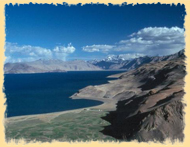 SAMSTANLING GOMPA: Samstanling Monastery was founded by Lama Tsultrim Nima and Monastic community was introduced as Rezong Gompa. About 50-60 monks are residing at this 132 years old monastery. The Gompa has some strict rules and regulations. SAMSTANLING GOMPA: Samstanling Monastery was founded by Lama Tsultrim Nima and Monastic community was introduced as Rezong Gompa. About 50-60 monks are residing at this 132 years old monastery. The Gompa has some strict rules and regulations.
-Women are not allowed in the monastery after sunset and before sunrise.
-No smoking is allowed (not even bringing cigarettes packets) in the monastery.
-Alcohol and non-veg. Food are strictly prohibited.
-Do not enter in sleeveless shirts and Pants.
Day 09 : Nubra - Leh
Morning after Breakfast proceed for Leh, once again driving via Khardungla pass the World Highest Motorable road. Evening explore Leh bazaar for souvenir, visit Leh Jokhang or Leh Mosque by foot. Overnight at the hotel.
JOKHANG: the Ladakh Buddhist Association in 1957 built the small Gonpa opposite to SBI and known as Jokhang in the main bazaar, which is open throughout the day for visitors. The Gonpa contains statue of Joyo Rinpoche (crowned Buddha).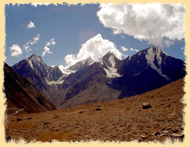
LEH MOSQUE: The Jama Masjid of Leh was built in 1666-67 AD under an agreement between Mughal Emperor Aurangzeb and Ladakhi ruler Deldan Namgyal. Initialy, the architecture of the mosque bore Tibetan, Central Asian and Ladakhi style. In recent years it has been reconstructed and given a new look with minarets and domes.
Day 10: Leh-Delhi.
Leave on time for Leh airport to board your flight to Delhi. Upon arrival no hotel envisaged. Later evening transfer to airport to board flight for onward destination on day 11.
|




 SHANTI STUPA (Japanese Peace Pagoda) : Shanti Stupa/Japanese peace pagoda is build by a Japanese religious organization headed by Head monk Nakamura with the help from the organization and local people. It is situated at a hill top in Cahngspa village providing a bird eye view of the Leh town and the surrounding mountain peaks. Architecturally it has the Japanese touch with small clean rooms on the side for meditators and the main Japanese shrine at the entrance.
SHANTI STUPA (Japanese Peace Pagoda) : Shanti Stupa/Japanese peace pagoda is build by a Japanese religious organization headed by Head monk Nakamura with the help from the organization and local people. It is situated at a hill top in Cahngspa village providing a bird eye view of the Leh town and the surrounding mountain peaks. Architecturally it has the Japanese touch with small clean rooms on the side for meditators and the main Japanese shrine at the entrance.
 STOK PALACE & MUSEUM: The palace of the banished royal family, Stok has a museum which displays fabulous period costumes and jewelry of the royalty along with exquisite Thankas representing the life style of Shakya Muni. Interesting historical objects like coins, armor, weapons, precious jades and porcelain too can be seen here.
STOK PALACE & MUSEUM: The palace of the banished royal family, Stok has a museum which displays fabulous period costumes and jewelry of the royalty along with exquisite Thankas representing the life style of Shakya Muni. Interesting historical objects like coins, armor, weapons, precious jades and porcelain too can be seen here.
 LAMAYURU GOMPA: The oldest holy site in Ladakh, it was a bon shrine prior to the advent of Buddhism. Also known as Yung Drung (Swastika) it is sited on a high promontory overlooking the village and valley. For sheer spectacle value no other Gompa can match Lamayuru.
LAMAYURU GOMPA: The oldest holy site in Ladakh, it was a bon shrine prior to the advent of Buddhism. Also known as Yung Drung (Swastika) it is sited on a high promontory overlooking the village and valley. For sheer spectacle value no other Gompa can match Lamayuru.
 SAMSTANLING GOMPA: Samstanling Monastery was founded by Lama Tsultrim Nima and Monastic community was introduced as Rezong Gompa. About 50-60 monks are residing at this 132 years old monastery. The Gompa has some strict rules and regulations.
SAMSTANLING GOMPA: Samstanling Monastery was founded by Lama Tsultrim Nima and Monastic community was introduced as Rezong Gompa. About 50-60 monks are residing at this 132 years old monastery. The Gompa has some strict rules and regulations.